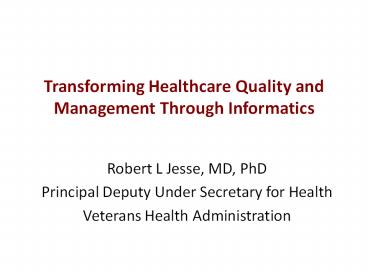Transforming Healthcare Quality and Management Through Informatics PowerPoint PPT Presentation
1 / 19
Title: Transforming Healthcare Quality and Management Through Informatics
1
Transforming Healthcare Quality and Management
Through Informatics
- Robert L Jesse, MD, PhD
- Principal Deputy Under Secretary for Health
- Veterans Health Administration
2
The Future of Healthcare in VHA
- Redefining healthcare networks
- From bricks-and-mortar to people
- Every patient will be a unique node on the
network - Transition from episodic to longitudinal care
- Span from prevention to end-of-life
- Optimize patient centered care
- Decentralization and distribution
- Transition the EMR to a Health Management
Platform (HMP) - Principled but rapid development processes
3
FROM CHART TO HEALTH MANAGEMENT PLATFORM
A Promising Future
A Successful Past
- Patient Facing
- Provider Facing
- System Facing
- Knowledge driven
- Agile
4
Transforming Healthcare
- Transactional Quality and Management
- a healthcare redesign process through which
clinical practices are both enhanced and ensured
by real-time insights into their systems. - Quality is integrated into the workflow
- Data is aggregated through the workflow process
- Quality and safety are driven by efficiency
5
Healthcare Informatics RedesignFundamentals
- Guiding Principle 1
- If data is important enough that it is needed to
manage the patient and/or the system, then it
must be acquired as an integral part of the work
process and not through retrospective data
collection.
6
Healthcare Informatics RedesignFundamentals
- We must know what were doing, not just what
weve done. - Systems control and quality management must be
integrated into care delivery and not be managed
as secondary processes. - Caveats
- Knowing what or which data are needed is
critical - New technologies will be required
- Usability, human factors, dashboards
- Context of data becomes vital
7
Healthcare Informatics RedesignFundamentals
- Guiding Principle 2
- Solutions must make the work easier, and not
impose undue burden or require re-work. - There should be NoPainfor the gain
- Technology must facilitate the workflow but not
drive it. - Technology must never encumber the work.
8
Healthcare Informatics RedesignFundamentals
- Guiding Principle 3
- Real-time visibility into the system must be
available, and it must be transparent across the
enterprise - Manage all patient-health system interactions
- location and times - waits and delays
- Manage patient-staff relationships
- Include patient-staff transitions (handoffs)
- Manage all tests and procedures in real-time
- From scheduling to completion
- Concurrent documentation
9
Patient VisibilityKey Component for the
Intelligent HMP
- Provide the right information ? to the right
people ?at the right time ? in the right place ?
in a comprehendible form - Automated Bed Boards (EDIS and inpatient BMS)
- Intelligent scheduling linked to activities
- Form Factors
- Mobile Computers
- Context driven views
- Comprehensive management of patient flow from
point of entry through to discharge - Automation of all processes that impact patient
flow
10
Healthcare Informatics RedesignFundamentals
- Guiding Principle 4
- In order to deliver evidence-based care we must
have evidence-based management. - Clinical processes support
- Administrative processes support
- IT support
- Materials management
- Point of service logistical support
- Systems engineering capability
11
Healthcare Informatics RedesignThe Fundamentals
- Guiding Principle 5
- In order to ensure that we effectively manage the
delivery of evidence-based care we must manage
complexity - Data Information Knowledge Wisdom
This requires a highly effective Electronic
Health Platform
12
Healthcare Informatics RedesignFundamentals
- Guiding Principle 6
- Informatics platforms must be context sensitive,
and they must be configurable and adaptable to
meet the needs of the user. - Team facing
- Multiple user types
- System facing
- Patient facing
- Support multiple devices for I/O
- Infinite configurability to enable all new models
of healthcare delivery (agility)
13
Summary
- Data must be acquired as an integral part of the
workflow process. - Adoption is dependant on workload burden.
- Real-time visibility into- and transparency
across the enterprise are required. - Evidence-based management is needed to ensure
evidence-based care. - Knowledge and complexity management are crucial
to moving forward. - Flexibility and adaptability to multiple users
needs
14
EHR Modernization
- Health Care Delivery Teams need
- Role and context-specific interfaces to clinical
systems - Greater support for workflow and cognitive tasks
- More powerful and integrated clinical decision
support
A provider facing Health Management Platform
15
EHR Modernization
- Successful patient care depends on participation
by activated patients. This requires - Personal Health Records
- Patient-oriented health libraries
- Modern communication platforms (social media)
- Self-management tools and resources
- Patient-centric I/O capabilities
A patient facing Health Management Platform
16
EHR Modernization
- Successful heath care delivery depends on a
functional healthcare system. - The system of records reflects the performance of
the health care delivery process - Registries and cohort management tools inform
both quality and performance management. - Intra- and inter-system performance comparisons
provide transparency into a systems health.
A system facing Health Management Platform
17
EHR Modernization
- Provider Facing
- Patient Facing
- System Facing
- Integrated Transactional - Agile
HMP Health Management Platform
18
The Future of Healthcare in VHA
- Redefining healthcare networks
- From bricks-and-mortar to people
- Every patient will be a unique node on the
network - Transition from episodic to longitudinal care
- Span from prevention to end-of-life
- Optimize patient centered care
- Decentralization and distribution
- ownership
- Transition the EMR to a Health Management
Platform (HMP) to enable the above - Principled and agile development
- Role and context based
19
Questions
- robert.jesse_at_va.gov

